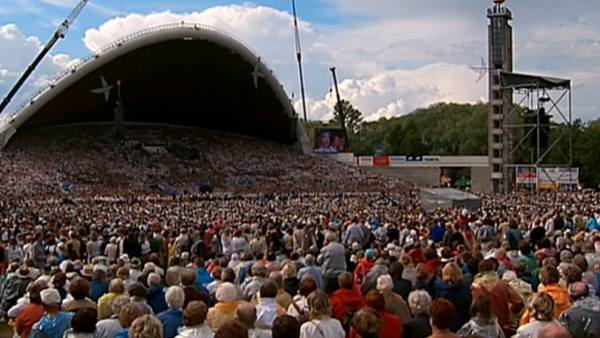Movie review by Greg Carlson
A worthwhile historical document, “The Singing Revolution” provides an impassioned clinic on civil disobedience and national unity as it chronicles the modern history of Estonia. Despite the promises of the movie’s trailer, “The Singing Revolution” does not focus the bulk of its attention on music, but spends much of its running time reconstructing a chronology that details Estonia’s grim status as a nearly perpetually occupied victim of mighty regional powers en route to its eventual independence in 1991. Well-paced and artfully crafted, “The Singing Revolution” will be of particular interest to people of Estonian heritage, but the movie also entertains and enlightens anyone captivated by the rare spectacle of non-violent political change.
Coined by artist and activist Heinz Valk in an article he wrote following a mass singing of folk songs and hymns at the 1988 Estonian Song Festival, or Laulupidu, the term “Singing Revolution” eventually came to be associated with Latvia and Lithuania as well as Estonia as a description of numerous musical and non-musical events demonstrating the desire of Baltic people to free themselves from Soviet occupation and rule. Despite being essentially forbidden, the music performed during the song festivals galvanized the citizenry, and some observers claim that more than a fourth of the entire population of Estonia participated in the 1988 Laulupidu.
Assisted by Linda Hunt’s expert narration, directors James Tusty and Maureen Castle Tusty blend a wealth of archival footage with contemporary interviews. The vintage newsreel and historical material contains a number of unflinchingly brutal and graphic images, including World War II-era clips in which prisoners are executed at point blank range. The horrific nature of some of the atrocities perpetrated against the Estonians contrasts sharply with the peaceful protesting espoused by group singing, and younger viewers might find the depictions of death disturbing. The inclusion of this content, however, underscores what was at stake.
The filmmakers include a great deal of nicely arranged information, but a few sequences leave out enough detail to frustrate viewers hoping for more depth than breadth. For example, the fascinating anti-Soviet guerilla movement known as the Forest Brothers, or Metsavennad, is tantalizingly introduced via an interview with a surviving member who shows off one of the underground hideouts used by the resistance soldiers. The sequence is brief and the Forest Brothers are ultimately glossed over as the film turns its attention to other significant dates and events. Later set pieces, including the August 1991 standoff at the Tallinn TV tower, are rendered more vividly.
“The Singing Revolution” discusses mass singing more than it actually shows it happening, but when the movie does intercut huge choral performances with the extensive interviews, the result can be emotionally moving. The film itself wears the pride of cultural heritage on its sleeve, but one cannot help but smile at the pluck and determination of the Estonian faithful who persevered for generations against the odds. Taking advantage of Mikhail Gorbachev’s perestroika and glasnost policies, Estonians embarked on an unshakable journey to nationhood. “The Singing Revolution” effectively shares this story with moviegoers who might not know the tale.
